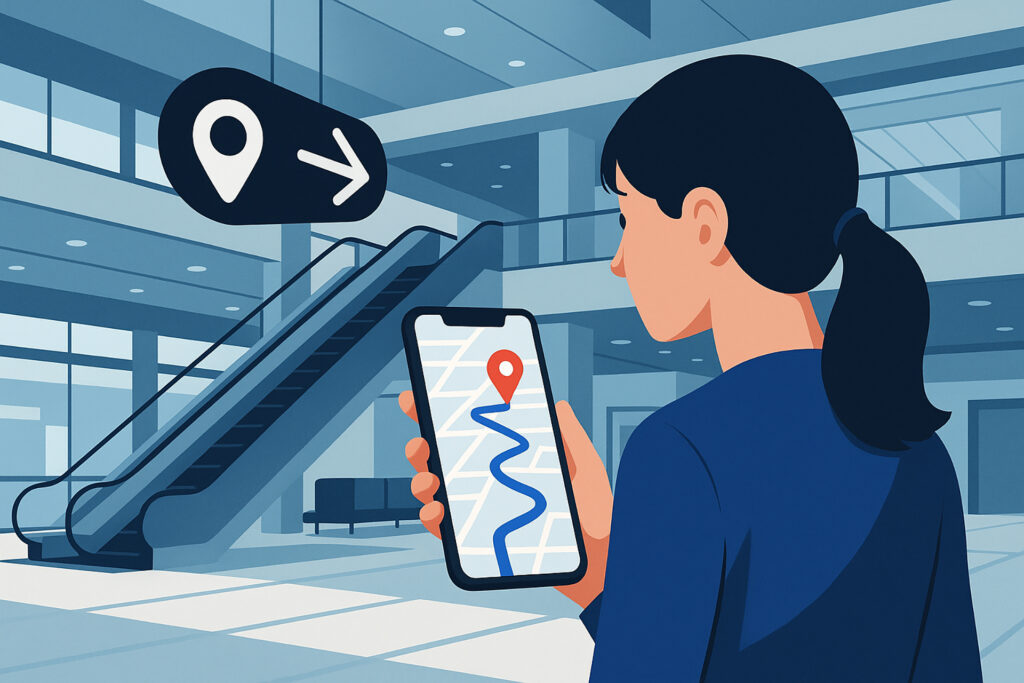Finding your way through a busy airport, sprawling shopping mall, or multi-building campus can be a challenge. Signs are often unclear, printed maps quickly become outdated, and even staff directions can be inconsistent. Real-time Indoor Positioning Systems (IPS) are solving this problem, giving visitors live, turn-by-turn navigation that adapts to the space around them — and creating measurable business value in the process.
What Is Real-Time Indoor Positioning?
IPS technology uses Bluetooth beacons, Wi-Fi signals, and other sensors to pinpoint a visitor’s exact location indoors — where GPS simply can’t. When paired with an interactive map, it works like a live, indoor GPS, updating in real time as the visitor moves and conditions change. The result is an experience that’s more accurate, faster, and more responsive than static directories.
1. Accurate Navigation in Complex Environments
In large venues, a single wrong turn can mean wasted time, missed connections, and frustrated visitors. Real-time IPS eliminates that friction with:
- Precise, step-by-step directions that update instantly based on location.
- Multi-level guidance to handle stairs, elevators, and complex floor layouts.
- Automatic detours when a route is blocked by construction, events, or security restrictions.
By removing the uncertainty from navigation, operators improve visitor satisfaction while keeping traffic flowing smoothly.
2. Data-Driven Insights to Maximize ROI
IPS isn’t just about helping people find their way — it’s also a powerful analytics tool. Every movement, search, and interaction reveals patterns in how visitors use the space. With the right platform, operators can:
- Visualize foot traffic and dwell time in different zones.
- Identify search trends and top destinations.
- Measure promotion and event impact in real time.
This data makes it easier to optimize layouts, improve tenant mix, and justify premium leasing rates, turning navigation into a direct revenue driver.
3. Real-Time Updates That Keep Pace with Change
Airports change gate assignments by the hour, malls constantly rotate store layouts, and campuses host events that temporarily redirect foot traffic. IPS keeps pace by:
- Instantly updating maps with new locations and closures.
- Sending push notifications for time-sensitive changes or offers.
- Letting users seamlessly move from kiosk to mobile with a quick QR scan.
Visitors get accurate information the moment they need it, while operators avoid the cost and confusion of outdated signage.
4. Inclusive Navigation for Every Visitor
True accessibility means more than just adding ramps — it means ensuring everyone can navigate independently. IPS platforms can provide:
- Wheelchair-accessible routing that avoids stairs and steep grades.
- Audio-guided directions for blind or visually impaired users.
- Multi-language support to serve diverse audiences.
These features ensure no visitor is left behind, creating a more welcoming and inclusive environment.
The Future of Navigation Is Live and Intelligent
Real-time IPS is becoming a must-have for any large venue that wants to deliver a frictionless, personalized, and data-driven visitor experience. It removes guesswork for guests, gives operators actionable insights, and creates new opportunities for revenue.
If you want to make your space easier to navigate while unlocking the value of visitor behavior data, now is the time to act.
See what’s possible with real-time indoor positioning. Book a demo with MapVX and start building a smarter, more connected space today.



